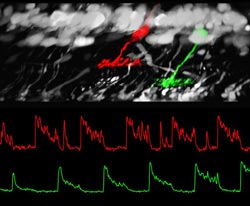

Until now, it was widely believed that this step takes place in the retinal ganglion cells, the output neurons of the retina. Scientists in the lab of Thomas Euler at the University of Tübingen, the Werner Reichardt Centre for Integrative Neuroscience and the Bernstein Center Tübingen were now able to show that already bipolar cells can generate “digital” signals.
At least three types of mouse BC showed clear evidence of fast and stereotypic action potentials, so called “spikes”. These results show that the retina is by no means as well understood as is commonly believed.
The retina in our eyes is not just a sheet of light sensors that – like a camera chip – faithfully transmits patterns of light to the brain. Rather, it performs complex computations, extracting several features from the visual stimuli, e.g., whether the light intensity at a certain place increases or decreases, in which direction a light source moves or whether there is an edge in the image. To transmit this information reliably across the optic nerve – acting as a kind of a cable – to the brain, the retina reformats it into a succession of stereotypic action potentials – it “digitizes” it.
Classical textbook knowledge holds that this digital code – similar to the one employed by computers – is applied only in the retina’s ganglion cells, which send the information to the brain. Almost all other cells in the retina were believed to employ graded, analogue signals. But the Tübingen scientists could now show that, in mammals, already the bipolar cells, which are situated right after the photoreceptors within the retinal network, are able to work in a “digital mode” as well.
Using a new experimental technique, Tom Baden and colleagues recorded signals in the synaptic terminals of bipolar cells in the mouse retina. Based on the responses of these cells to simple light stimuli, they were able to separate the neurons into eight different response types. These types closely resembled those expected from physiological and anatomical studies. But surprisingly, the responses of the fastest cell types looked quite different than expected: they were fast, stereotypic and occurred in an all-or-nothing instead of a graded fashion. All these are typical features of action potentials.
Such “digital” signals had occasionally been observed in bipolar cells before, but these were believed to be rare exceptional cases. Studies from the past two years on the fish retina had already cast doubt on the long-held belief that BCs do not spike. The new data from Tübingen clearly show that these “digital” signals are systematically generated in certain types of mammalian bipolar cells. Action potentials allow for much faster and temporally more precise signal transmission than graded potentials, thus offering advantages in certain situations. The results from Tübingen call a widely held dogma of neuroscience into question – and open up many new questions.
The Bernstein Center Tübingen is part of the National Bernstein Network Computational Neuroscience in Germany. With this funding initiative, the German Federal Ministry of Education and Research (BMBF) supports the new discipline of Computational Neuroscience since 2004 with over 150 Mio. €. The network is named after the German physiologist Julius Bernstein (1835–1917).
Text:
Simone Cardoso de Oliveira, Philipp Behrens
Original Publication:
Baden T., Berens P., Bethge M., Euler T. (2012): „Spikes in Mammalian Bipolar Cells Support Temporal Layering of the Inner Retina“. Current Biology: Dec 13, 2012.
http://dx.doi.org/10.1016/j.cub.2012.11.006
Contact:
Dr. Tom Baden
Eberhard Karls Universität Tübingen
Werner Reichardt Centre for Integrative Neuroscience (CIN) / Institute for Ophthalmic Research
Otfried-Mueller-Strasse 25
72076 Tuebingen
Phone: +49 (0)7071 29 84749
thomas.baden@uni-tuebingen.de
Prof. Thomas Euler
Eberhard Karls Universität Tübingen
Werner Reichardt Centre for Integrative Neuroscience (CIN) / Institute for Ophthalmic Research
Otfried-Mueller-Strasse 25
72076 Tuebingen
Phone: +49 (0)7071 29 85028
thomas.euler@cin.uni-tuebingen.de
Weitere Informationen:
http://www.eulerlab.de
Website of the Euler Lab
http://www.bccn-tuebingen.de
Bernstein Center Tübingen
http://www.cin.uni-tuebingen.de
Werner Reichardt Centre for Integrative Neuroscience
http://www.uni-tuebingen.de
University of Tübingen
http://www.nncn.de
National Bernstein Network Computational Neuroscience














